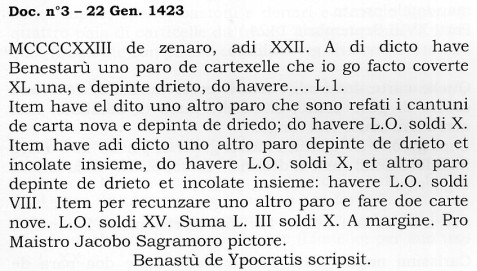Iacopo Sagramoro, Trionfi Card Painter in Ferrara
composed by Lothar Teikemeier, last updated 06.12.2012
First recorded activity in Ferrara: 1422-03-23
First Trionfi context in Ferrara: 1441-01-01 or 1442-02-10
Last recorded activity in Ferrara: 1454-12-18
|
Dates of Playing Card / Trionfi activities
- 1422-03-23 Ferrara - 13 cards and 4 backs of suits or decks (6 Lira Marchesana)
- 1423-01-22 Ferrara - repair action of some cards (totally 3 Lira Marchesana 10 Soldi)
- 1437-06-04 Ferrara - "due para de carteselle"
- 1437-08-30 Ferrara - "due para de carteselle"
- 1441-01-01 Ferrara - 14 figure for Bianca Maria Visconti (2 Lira Marchesana 5 Soldi)
- 1442-02-10 Ferrara - 4 Trionfi decks (totally 20 Lira Marchesana)
- 1442-07-28 Ferrara - Burdochi 1 Trionfi deck (12 Soldi 3 Denari)
- 1450-03-16 Ferrara - 3 Trionfi decks (totally 3 [4.5] Lira Marchesana)
- 1451-08-22 Ferrara - 1 Trionfi deck (4 [5] Lira Marchesana)
- 1454-02-13 Ferrara - 1 Trionfi deck (12 Lira Marchesana 10 Soldi)
- 1454-04-09 Ferrara - painting the backs of cards of 1 Trionfi deck
- 1454-12-18 Ferrara -1 Trionfi deck (11 Lira Marchesana 10 Soldi)
|
|
Sources
Sources for Trionfi cards in Ferrara are mainly taken from our
earlier collection at Trionfi.com based mainly on the work of Gherardo Ortalli and Adriano Franceschini, expressed in the article of Ortalli
"The Prince and the Playing Cards" (1996).
| SOURCE 1: Iacopo Sagramoro
|
|
Quote from my own texts, c. 2003-2005: Iacopo Sagramoro (? - c. 1459) Naturally these older texts present not in all points my opinion of nowadays. The new text here might contain some corrections against the earlier versions.
|
Iacopo Sagramoro (- ca. 1459)
a man for the cheap things, for instance Tarot Cards
Jacopo di Batheolomeo Sagramoro seems to have had also the name of Iacopo da Bononia (=Bologna)
or Iacopo da Soncino, although both are different locations.
His name is connected to the first entry
about playing cards in Ferrara (1422),
with this Sagramoro is in concurrence to Michelino da Besozzo as first mentioned playing card painter in Italy. Also
to some playing cards in the 30ies, to the great riddle, the present to Bianca Maria in January 1441,
to the first use of the name
"Trionfi" (1442), in context with Marchione Burdochi and beside the Bembo-school in Cremona Sagramoro is the "great
Trionfi painter" in the years 1450 - 1456, when Trionfi started to be a well known and much used card deck
(he is active till 1456 and appears in the documents B 01 04 07
09 10 15 18 ).
But another fact: Sagramoro is simply the most mentioned artist in more than 30 years of all the Este account books. He is the grey
humble man in the background, not really noted, as
he always was there.
Always good for the small not so well paid jobs (Ortalli mentions, that he was very often employed by the d'Este court, working
"on friezes, the decorations of ceilings, walls, tracery as well as court carriages, pennons, crests, flags, nuptial trunks,
harnesses, pattern for fabrics and embroidery"). Art historians forget about him. Mostly he painted heraldic
designs, as they were needed everywhere to show: this is property of the d'Este. And this is property of the d'Este. And this ...
and often - this was Sagramoro. A boring job. Probably Sagramoro developed tricks to become quick with it. And because of that: He was cheap.
When it came to
paint playing cards, many, many playing cards, again a boring matter, Sagramoro knew about the tricks to make them without too much effort.
So he was cheap and useful in this job. And cause of this reason: He got the job.
So it happened: Sagramoro became Trionfi-painter. He was already old, when this occupation
developed and his style probably was a little bit old-fashioned.
The interpretations of the entries about playing cards in the account books are
difficult, Ortalli presents the opinion, that it occasionally appears, as if Sagramoro were only and mainly occupied with
"repairing cards" or "with painting the
back of cards" (possibly according to his
specialisation on heraldic devices, which were probably the decorations on the backs of the cards dedicated for the courtly use).
The playing card at the right possibly had been painted by Sagramoro. The motive is unclear: Fortuna or Chariot?
Fortuna and Chariot might have been part of the Imperatori deck, so this card might be the final fragment of such a deck
(in that case the Ferrarese specialist for Imperatori-cards, Piero Andrea de Bonsignore, might have been the artist).
Sagramoro, a minor, more or less unknown artist
The only biographical information available about Sagramoro comes from the archives published by Franceschini. Sagramoro had a
daughter Dorothea, who in 1459 was given title to lands which had been given to her father in 1444 - probably 1459 is the year of
Sagromoros death; he made his last will two times, in 1456 and 1457 and was replaced as main courtly Trionfi painter by Gherardo da Viczenza.
Gherardo was also already old, when getting the place of Sagramoro. Probably both were used to the old-fashioned style, Gherardo could imitate it.
Another source about Sagramoro is in Giuseppe Campori, 1885, "I pittori degli Estensi nel secolo XV" pp. 538-539, momentary not available.
Sagramoro, the great Tarot-painter
Sagramoro is mentioned in the first entry about playing cards in Ferrara in 1422. Sagramoro worked for
Parasina and probably had greater insights of the tragedy in 1425. He cooperated with the printer, who appeared around
1436 with a printing-press for playing cards in Ferrara and experienced the progress of technology.
Sagramoro painted 14 figures on cotton-paper for Bianca Maria for the amusement in the evening and was paid on 1st January 1441
- a great entry, who might carry the mystery about the invention of the 5x14-deck with 5th trumps-suit. In February 1442 Sagramoro
is payed for the production of 4 Trionfi decks - it's the first note about a Trionfi-deck.
Sagramoro became the great Trionfi or Tarot painter in Ferrara in the years 1450 - 56 in high age - probably 5x14-decks.
After 1456 the artist Gherardo d'Andrea da Vicenza appears on the scene and it seems, that he took the job of Sagramoro as
card-painter. His first production (1457) mentions a Trionfi-deck with 70 cards - probably still a 5x14-deck, perhaps the form, that
Sagramoro developed in cooperation with some highborn teenagers and kids in the winter of a great decision in 1440/1441.
And Sagramoro passed away, not knowing, that he became the hidden star of an internet page more than 500 years after his death.
Well, the king of the 5x14-deck.
|
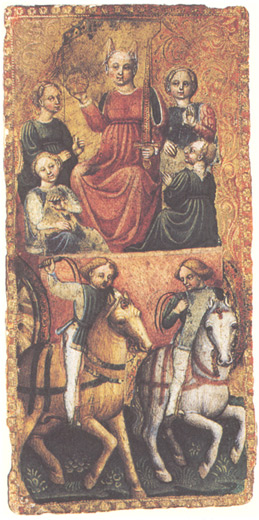 |
|
| SOURCE 2: Iacopo Sagramoro - document of 1422
|
The first Note about Playing Cards in Ferrara
The account books of Ferrara have provided us with lots of entries about playing cards.
In them we find the first reference to Imperatori cards in 1423, the first mention of Trionfi cards in 1442,
the important
entry about a 70 card-game in 1457 and the first note about Tarocchi cards in 1505. Also we find there the mysterious
entry about a present to Bianca Maria on the 1st of January 1441, which might be the key to the origin of the
5x14-Trionfi-deck. And some more of the of the documents, that you find exposed in our chapter about the use of the name Trionfi.
The first entry, which relates to playing cards in these books, is from 1422 and it is unclear, what is talked about.
Is it about a general repairing action of some decks with some not understandable and confusing details, as
Ortalli in The Prince and the Playing Cards
suggested,
or is it about a simple "updating action", in which a 4x13-deck is changed to a 5x13-deck?
With the Pierpont-Morgan-Bergamo-deck we've - eventually - another example for an "updating action"
(from a 5x14-deck to a 4x14 + 20-deck), the Ferrarese entry from 1422 strengthen the argument there.
A deciding role plays the first word in the fourth line. Does it mean, as in the description below suggested,
"para", implying "pack (of cartes)" or is it an expression of "suits"? Or could, as there are not much doubts, that it
really means "para", this word also have been used for something like "suit"? Boiardo uses for suit "colora", colours, a word
still in use in European languages for suits, but it is not clear, if this word was already in use in the year 1422.
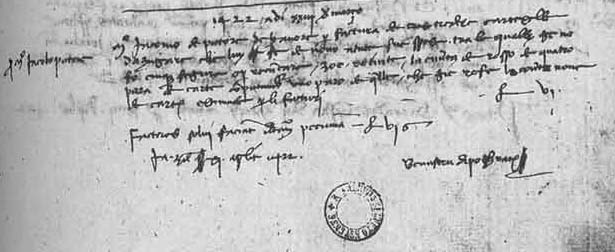
1422, adi XXIII de marco,
Maistro Iacomo depictore de havere per factura de tredexe cartexelle da zugare che luy fe de novo a tute sue spexe, tra le qualle ge ne fo cinque figure, o per recuncare, zoe retinte la cuverta de rosso de quattre para de carte, computantdo una para de quelle
che gie refe le cuverte nove de carte extimade per li factura L. VI.
Factures solvi faciant dictam pecuniam L. VI.
Iacobus Zilfredus scripsit XI aprilis 1422
Benastru d'Ipocratibus |
Ortalli writes: "In a register of Este Camera Ducale payments we find that a certain "Iacomo depictore" was due 6 lire for
"13 new playing cards entirely re-made at his expense, including 5 figure cards, and for repairing , that is, repainting red
the covers of four packs, the cost of the new covers being valued as one pack by the factors".
"Iacomo depinctore" is identified as Iacobo di Bartolomeo Sagromoro, a painter, who was very often employed by the d'Este court. He worked "on friezes, the decorations of ceilings, walls, tracery as well as court carriages, pennons, crests, flags, nuptial trunks, harnesses, pattern for fabrics and embroidery".
Ortalli interprets the passage: "In the 1422 document he (Iacopo Sagramoro) had been given a twofold task: he had to repair
4 packs of playing cards to be painted red on the back, and make 'ex novo' 13 'cartexelle', five of which were figures (and
therefore the other 8 numerales). It is difficult to say whether these new cards were or were not an independent pack; they
may even have been required for some game with only 13 cards of which we have lost all trace. I would surmise it is more likely
that the new cards were intended to replace missing or irreparably damaged cards in the four packs to be repaired, and since
the backs of all the cards were repainted the new cards would not stand out from the old ones." In context to this Ortalli
relates to another entry from 1423, in which Sagramoro also was used as card-restorator: "... he had to repair the back, fix the
corner, glue down where necessary and make two new cards." We will meet Sagramoro at other occasions: although being a painter
of probably only minor value, he became the great Trionfi artist of the early time.
In my opinion the entry from 1422 has another possibility of interpretation: Sagramoro made 13 new cards to update an already existing 4x13-deck to a 5x13-deck. This deck had 5 figures (probably the normal 3 court cards + a figurative drawn "ace" and "ten" and 8 numbers (2 - 9). He had to repaint the back of the old 52 cards to make them look in the same way as the new cards, otherwise the opponents in game could decipher some information about the content of the hand of the other players. Decks with a 5th suit are already known from the document of Johannes von Rheinfelden from the year 1377 (a 5x13-deck is mentioned), although some informations are suspected to be added at a later time (perhaps in 1429). In the case, that the special passage in the Johannes von Rheinfelden text was added later, the above quotation might be the oldest entry about a deck with a 5th suit. However, it is not impossible, that Ortallis interpretation was correct.
|
| SOURCE 3: Iacopo Sagramoro - document of 1423
|
| SOURCE 4: Iacopo Sagramoro - documents of 1437
|
|
Quote from my own texts, c. 2003-2005: Iacopo Sagramoro (? - c. 1459) Naturally these older texts present not in all points my opinion of nowadays. The new text here might contain some corrections against the earlier versions.
|
| SOURCE 5: Iacopo Sagramoro - documents of 1441
|
|
Quote from my own texts, 2003: Ferrara 1441 (1st of January, 1441) Naturally these older texts present not in all points my opinion of nowadays. The new text here might contain some corrections against the earlier versions.
|
Ferrara 1441
A new document was detected in March 2003, perhaps relating to the first appearance of a 5x14-deck with 14 "Trionfi" (figure) as a 5th suit. It might cause a revolution in playing card research.
In our studies around the 5x14-theory Ross Gregory Caldwell discovered
in March 2003 a strange entry in the Ferrarese account books: At the 1st
of January of 1441 the painter Sagramoro got money for having
painted "14 figure" (14 figures) on a special paper (which was also in
use for the production of playing cards), which were intended for an
unspecified use at a "party at night" for the guest Bianca Maria
Visconti, 15-years-old single daughter of the duke of Milano Filippo
Maria Visconti, who is well known for his interests in the production of
unusual playing-card decks.
The entry alarmed us. "14" was the "right" number, and we were searching for better evidence for the 5x14-theory .... however, in the entry an expression like "playing cards" or "ludus triumphorum" or "Trionfi" was missing. What was the object, for which Sagramoro was paid? What paintings could be of use for a "party at night"?
Our research did begin ...
What's so alarming in this entry?
- The location is right: Ferrara is suspected as one of the possible locations for the origin of Tarotcards, the first note about Trionfi cards appears here.
- The time is right: 1st of January 1441, this entry (1441)
is short before the other entry, in which "Trionfi" (1442) is noted for
the first time.
- The time of the year is right. Winter was the natural time for playing (long nights, nothing to do on the outside) and specific the day of 1st of January seems to have a day for games (reported from a German city, so not necessarily true for Ferrara).
- The painter is right: Sagramoro is later the painter for the first mentioned Trionfi decks in February 1442.
- The commissioner is right, probably Leonello. He is later also
the commissioner of the first 4 Trionfi decks.
- The receiver is right. Bianca Maria is the daughter of the Milanese duke Filippo Maria Visconti, and Filippo is variously connected to early Trionfi cards. Additional to that Bianca Maria is later involved in the production of the Bembo cards, which are produced in Cremona and that is "her" city.
- The term "figure" is right. It is later used also in the Trionfi document of 1442.
- The "party at night" is right. Playing cards are for amusement.
- Last - but not least, the number is right: 14. Ferrara is the location, where 16 years later, in 1457 another alarming document appears, in which it turns out, that a Trionfi-deck might consist of 70 cards - not of 78, as the theory of an "original deck with 22 trumps" would demand it.
However, any term, which indicates directly "Trionfi" or other playing
cards, is missing. This was annoying, but ...
Well, the missing of the term "Trionfi " is not surprizing or
illogical. A deck can exist without having a specific name, in many
other examples first an invention is done and the name to the object is
given later. As the name of "Trionfi" in relation to a playing card deck
first appears in February 1442 (as far as we know) the missing of the
name in January 1441 doesn't mean a contradiction. It might just
indicate, that that, what is produced in January 1441 has the character
of an invention ... The Invention of Tarot? No, only the invention
of the 5x14-deck including 14 "special figures", just that, what later
became the major Trionfi-version for a longer time, perhaps already
intended to play the role of a 5th predefined trump-suit.
Is the missing of the words "playing cards" a contradiction? No, not
really. If it really was an "innovative situation" at that evening of
1st of January 1441 or around that time, then perhaps Sagramoro
only made projecting paintings, just being on their way to become Tarot
cards later. Or the words "playing cards" are just not written ...
perhaps, cause these "14 figure" had been strange playing cards, until
then unknown objects, so it was near to the writer in the account book
to speak of "14 figure" instead of "playing cards".
Why "14 figure", why not 70 cards? The Este had already playing cards of the usual kind, they only needed to add 14 Trionfi cards to update an already existing deck.
Why just Bianca Maria Visconti? The situation is logical ... As one of possibly not many persons just Bianca Maria "must" have known the playing cards experiments of her father, at least the Michelino deck, which was produced before 1425. We don't know the date of the Cary-Yale Tarocchi, perhaps it did already exist or it didn't exist.
In the case, that Bianca Maria - a 15 years-old-girl in her first situation of a public appearance at a foreign court as an honoured guest - told in her communications at the Ferrarese court of the interesting decks of her father, this might have induced her host, Leonello (in this special case - an interesting political situation - a possible husband-in-spe), to please the guest with a production of his own in the same field, intended as "a present for the guest" or as a "sign of love" or similar.
We researched the case, turning any stone, that we did see around the date and the location, Ferrara 1441 ...Our results you can visit here, still a little unfinished, as it is a situation "in research".
A final security, if the 5x14-deck was just invented at this occasion,
was not possible to reach - but, we're rather near to a rather good
story. "Leonello invented the 5x14-deck cause of love to Bianca Maria",
or "three young girls designed the early Tarot", this are possible
conclusions ... but, of course, not with 100 % security, just
ideas to settle the various informations into a shape.
Anyway, an interesting object ...
| |
| SOURCE 6: Iacopo Sagramoro - document of 1442
|
Quote from the earlier Trionfi notes collection of Trionfi.com (2003-07): Document 1 [old counting] / Sagramoro 1442. Naturally these older texts present not in all points my opinion of nowadays.
The new text here might contain some corrections against the earlier versions.
|
Document 01 [old counting]
This is the oldest known reference of the word "Trionfi" in context to playing cards.
The payment was done at the 10th of February 1442 short after the death of Niccolo III d'Este,
perhaps the production was already ordered by the new Signore of Ferrara, Leonello (perhaps indicating, that such experiments
couldn't have happened under the reignment of Niccolo). Another possibility might be, that the Cary-Yale deck really
was produced in October 1441 at the occasion of the marriage of Francesco Sforza and
Bianca Maria Visconti and that this action induced an interest at the Ferrarese court to participate at this "modern" way of playing.
The text notes the suits "cups", "swords", "coins" and "batons", which is missing in later entries of the Ferrarese account books. Perhaps this can be interpreted as a sign,
that the whole composition of the deck is new in 1442. The price of 5 Lira per para (pack of cards) is equal to the salary for 2-3 monthes of work of a humble worker and around the 1/4 of a monthly income of a common noble man. Galioto de l'Asassino is the adminstrating person, he appears rather often till ca. 1457.
Compare our excessive article Ferrara 1441.
|
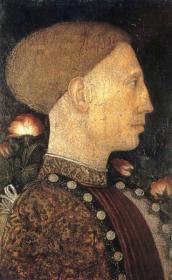 |
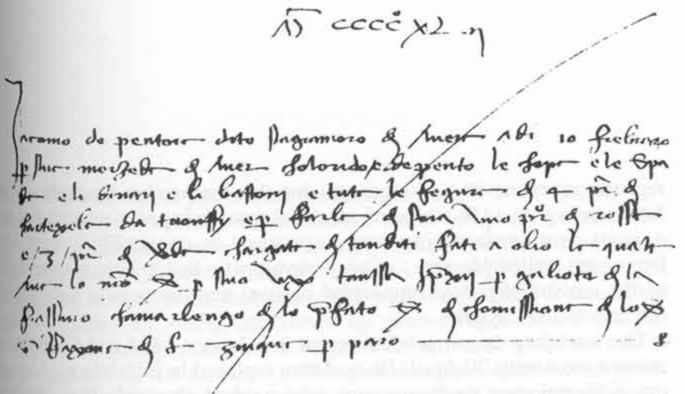
1442 [10 February payment to Iacomo de Sagramoro]:
Maistro Iacomo depentore dito Sagramoro de avere adi 10 fiebraro per sue merzede de avere cho(lo)rido e depento le chope e le spade e li dinari e li bastoni e tutte le figure de 4 para de chartexele da trionffi, e per farle de fora uno paro de rosse e 3 para de verde, chargate de tonditi fati a olio, le quale ave lo nostro Signore per suo uxo; tanssΰ I precii per Galioto de l'Asassino chamarlengo de lo
prefato Signore de chomissione de lo Signore, in raxone de lire zinque per paro
L. XX.
[Franceschini 1993 n. 481c (p. 221) ; Ortalli 1996b:184-5 and marginal note 5: page 185 contains a facsimile of the original text.] |
Preliminary translation by Ross Gregory CaldwellMaestro Jacomo, painter, called Sagramoro, having on the 10th of February for his recompense, for having coloured and painted the cups and the swords and the coins and batons and all the figures of 4 packs of small triumph cards, and for making of the backs one pack red and 3 packs green, decorated with roundels made in oil, which our Lord had for his use; deducted 1 precii by Galioto de lAsassino chamberlain of the aforesaid Lord by commission of the Lord; at the rate of five lire per pack ........ L. XX.
|
<
|
| SOURCE 7: Marchione Burdochi - document of 1442
|
Quote from the earlier Trionfi notes collection of Trionfi.com (2003-07): Document 2 [old counting] / Burdochi/Sagramoro 1442. Naturally these older texts present not in all points my opinion of nowadays.
The new text here might contain some corrections against the earlier versions.
|
Document 02 [old counting]
Sigismondo and Ercole, the brothers of Leonello, are 9 and 11 years old, so this document refers to a deck for kids.
This is the second entry about Trionfi from Ferrara (same year as the first). After that Trionfi is not mentioned for 8 years in Ferrara in the account books, so one might conclude, that the interest in them is not very high at the beginning. Perhaps they were only interesting to kids, which loved the new figures.
Instead of further early notes about Trionfi decks appear 4 [corrected] entries, which document an interest in
Imperatori cards (1443).
The price for the Trionfi cards is around 12 soldi, which is around 1/8 of the price, which was paid for a single deck for Leonello in February, but, considering, that this is only "for the kids", this doesn't surprize. Still it is a rather expensive toy (a humble worker had
to work a week for this sum) and doesn't allow the conclusion, that a mass market for Trionfi deck existed at this time.
Ercole became later duke of Ferrara and it is assumed, that most of the playing cards that we know from Ferrara are commissioned under his rule.
From Sigismondo is known, that he later lost heavy sums of money in gambling. The merchant Burdochi had in the year 1442 various exchanges with Sagramoro, the painter of the first mentioned Trionfi cards. From later years nothing is known
about Burdochi, Sagramoro became the favoured Trionfi painter till 1456.
Compare: Kids and Burdochi
|
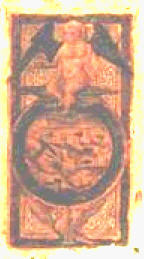 |
1442 [28 July credit to Marchione Burdochi, merchant]:
E adi dicto per uno paro de carte da trionfi; ave Iacomo guerzo famelio per uxo de Messer Erchules e Sigismondo frateli de lo Signore.
Apare mandato a c___,
L. 0.XII.III
[Franceschini 1996:170; cf. Bertoni 1917:220 note 3] |
Preliminary translation by Ross Gregory Caldwell2) And on the said day for one pack of triumph cards; has Iacomo cross-eyed, servant, for the use of Masters Ercole and Sigismondo brothers of the Lord. Appearing in mandate at c. ______,
.L. 0. XII. III |
|
| SOURCE 8: Sagramoro - document of 1450
|
Quote from the earlier Trionfi notes collection of Trionfi.com (2003-07): Document 4 [old counting] / Sagramoro 1450. Naturally these older texts present not in all points my opinion of nowadays.
The new text here might contain some corrections against the earlier versions.
|
Document 04 [old counting]
With this Sagramoro appears again after a pause of 8 years in 1450 as painter of Trionfi cards. It becomes a maior occupation to him for the next 6 years. The interests for Imperatori-decks in Ferrara died around this time, they are not produced after 1452 (as far we know). Perhaps they were similar to Trionfi cards (but with less special cards) and the motifs "merged" in the Trionfi deck.
Compare our chapter about the Imperatori cards and the gathered documents to this form of deck in Ferrara and other places.
1450 [16 March payment to Iacomo de Sagramoro]
Maistro Iachomo dito Sagramoro depintore de havere adi XVI marzo per fatura e spexa de depinzere a tute sue spexe para trea de charte da trionfi, zoθ per depinzere para doa de fuora via le coperte de verde dito azuro de lavori fati nigri a olio, e para uno fate de braxilio charestato tute de fuora via del dito braxilio taiate de schachiti
fati de negro e a olio. Domanda el dito Maistro Iachomo lire 1, soldi 10 de marchesani per paro, e Galeoto gie tassa lire 1 de marchesani per paro
L. III.
[Franceschini 1993 n. 647 d. (p. 342) ; cf. Ortalli 1996b: 185] |
Preliminary translation
(by Ross Gregory Caldwell)Maestro Jacomo called Sagramoro, painter, having the 16th day of March for the making and expense of painting, at his expense, three packs of triumph cards, painting the backs of two packs of green called azure
black with oil, and the back of one pack of brazil
of that called brazilwood, checkered in black with oil. Requesting the said Master Jacomo 1 lire, 10 soldi marchesane per pack, and Galeoto taking tax 1 lire marchesane per pack
. L. III.
| |
| SOURCE 9: Sagramoro - document of 1451
|
Quote from the earlier Trionfi notes collection of Trionfi.com (2003-07): Document 7 [old counting] / Sagramoro 1451. Naturally these older texts present not in all points my opinion of nowadays.
The new text here might contain some corrections against the earlier versions.
|
Document 07 [old counting]
| This is the first Trionfi production under the reignment of Borso d'Este, his brother Leonello had died in October 1450. Although it might be assumed, that Leonello took an excessive influence at the origin of the 5x14-deck, it must be stated, that he showed no great interest in the development of the game. It was Borso who engaged with many actions in the production of Trionfi decks. But in the art activitities at the Ferrarese court this probably played only a minor role. One main product under Borso was the Este Bible, perhaps the most expensive book of all times, created in 5 years between 1455 - 1460. Another famous object became the Palazzo Schifanoia and its decoration with an astrological scheme of the antique astronomer Manilius. |
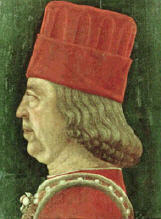 |
1451 [22 August* payment to Iacomo de Sagramoro]
Maistro Iachomo de Sagramoro depintore de avere adi XXIII de agosto* lire quarto de marchesani per sua mercede de avere depinto a tute sue spexe uno paro de charte da trionfi da lato drito per uxo delo Illustro nostro Signore; domanda lire 5 de marchesani e Galeotto gie tassa lire quarto de marchesani
..L. IIII.
[Franceschini 1993 n. 663i (p. 355)]
* Franceschini gives the date as 22 August, while his edited text
says 23 (XXIII) August. |
Preliminary translation
(by Ross Gregory Caldwell)Maestro Jacomo de Sagramoro, painter, having the 22nd day of August
four lire marchesane for his recompense, for having painted at his
expense the face of one pack of triumph cards, for the use of our
Illustrious Lord; asking 5 lire marchesane and Galeotto gie tassa
lire four marchesane
.. L. IIII.
| |
| SOURCE 10: Sagramoro - document of 1454/02
|
Quote from the earlier Trionfi notes collection of Trionfi.com (2003-07): Document 9 [old counting] / Sagramoro 1454/1. Naturally these older texts present not in all points my opinion of nowadays.
The new text here might contain some corrections against the earlier versions.
|
Document 09 [old counting]
1454 [note of 13 February payment to Iacomo Sagramoro]:
A Maistro Iacomo Sagramoro depintore insino adi XIII de decto (febbraio) libre dodece, soldi diece marchesani, per lo pretio de uno paro de carte le qualle lui ha lavorato al prefacto nostro Signore e messe d'oro fim, como appare mandato de la Sua Signoria registrato al Registro de l'anoo 1453, a c.____ ; al "Zornale AA" de ussita a c. 12
L. XII. X.
[Franceschini 1993 n. 726c (p. 410); cf. Ortalli 1996b:185]
Ortalli 1996:185 considers this pack to be one of carte da trionfi. |
Preliminary translation
(by Ross Gregory Caldwell)
To Maestro Jacomo Sagramoro, eminent painter, 13th of the aforesaid (February), twelve lire, ten soldi marchesane, for taking one pack of cards upon which he worked for the aforesaid our Lord and putting fine gold, as appears mandated from His Lordships registration in the Register of the year 1453, to c.____; in the Journal AA of ussita to c. 12
..L. XII. X.
| |
| SOURCE 11: Sagramoro - document of 1454/04
|
Quote from the earlier Trionfi notes collection of Trionfi.com (2003-07): Document 10 [old counting] / Sagramoro 1454/2. Naturally these older texts present not in all points my opinion of nowadays.
The new text here might contain some corrections against the earlier versions.
|
Document 10 [old counting]
| The peace of Lodi is signed at the 9th of April 1454. The changement in the political conditions might have raised the interests in card-playing in Ferrara, a lot of mercenaries could now "peaceful" develop their hobbies. In Ferrara we perceive an increasement of playing card production.
A similar card production fever takes place in Ferrara in 1516, after the French had conquered Milano for a second time (Ferrara was allied with the French forces). |
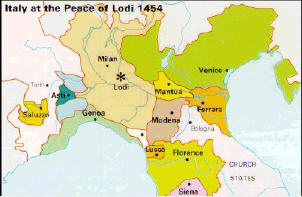 |
1454 [note of 13 April, payment to Iacomo Sagramoro]:
A Maistro Iacomo Sagramoro depintore adi XIII de aprile libre cinque marchesane per dui soi mandati, zioθ uno per sua fatica de havere depinto de fori uno paro de carte da triumffi, le qualle have Piedro de Schiveto per uso del prefacto nostro Signore, e per soa fatica de havere depinto una capsa cum le arme del prefato Signore, la qualle have Maistro Nicolo da le balestre per tenere le vere
quando el Signore tra de balestre, como al "Zornale AA" de ussita, a c. 30
L. V.
[Franceschini 1993 n. 726e (p. 410)] |
Preliminary translation
(by Ross Gregory Caldwell)
To Maestro Jacomo Sagramoro, painter, 13th day of April, five lire marchesane for two of his orders, that is to say one for his trouble in having painted the backs of one pack of triumph cards, which Piedro de Schiveto had for the use of the aforesaid our Lord, and for his trouble of having painted one box with the arms of the said Lord, which Maestro Nicolo had from the crossbows to hold the "vere" (arrows ?) when the Lord shot the crossbows, as in the "Journal AA" of ussita, at c. 30 ... L. V.
| |
| SOURCE 12: Sagramoro - document of 1456
|
Quote from the earlier Trionfi notes collection of Trionfi.com (2003-07): Document 15 [old counting] / Sagramoro 1454/2. Naturally these older texts present not in all points my opinion of nowadays.
The new text here might contain some corrections against the earlier versions.
|
Document 15 [old counting]
This is the last entry about Sagramoro in context to playing cards. Sagramoro was the most mentioned artist in the Ferrarese account books, he worked for more than 35 years in service of the d'Este court and his activities in card production had been only a small part of his occupation. In 1456/1457 he retired and was dead in 1459.
1456 [note for 18 December payment to Iacomo Sagramoro]
A Maistro Iacomo de Sagramoro depintore adi 18 de dicembre libre undece, soldi diece marchesani per sua mercede e spesa de havere depinto uno paro de carte da triumphi lavorate d'oro e argento a tute sue spese per uso delo Illustro nostro Signore, e consignato a Piedro de Schiveto e per lui a Zoanne de Romio, e questo per conto del fontico, e posto da loro a Libro CC, a c. 166 ; al "Memoriale CC",
c.____
L. XI. X.
[Franceschini 1993 n. 788c. (p. 461); cf. Ortalli 1996b:185] |
Preliminary translation
(by Ross Gregory Caldwell)
To Maestro Jacomo de Sagramoro, painter, the 18th day of December, eleven lire, ten soldi marchesane for his recompense and expenses for having painted one pack of triumph cards worked in gold and silver, all at his expense, for the use of our Illustrious Lord, and given to Piedro de Schiveto and by him to Giovanni de Romio, and which ... (...)
... L. XI. X.
|
|
Repeated Note:
When Ross Caldwell and me in 2003 started to collect Trionfi notes between 1442-1463, we had about 27/28 entries (which I nowadays would count as 31). The major part were the documents of Ferrara, which were collected by Gherardo Ortalli and Adriano Franceschini in the "Prince and the Playing Cards" (1996), after the base laying works of Michael Dummett and Stuart Kaplan around 1980. This collection included 2 notes about Trionfi cards in Florence, found by Franco Pratesi in his earlier work (allowances of the Trionfi game in 1450 and 1463). A graphical representation of this time (with 27 entries) shows the dominance of Ferrarese documents (in black) with a few notes only from other locations (in red; see picture to the right)
In the period 2004 till October 2011 it was possible to add 4 further notes (Siena 1452, Padova 1455, Ancona c. 1460 and Valerio Marcello c. 1460), mainly thanks to information given by Thierry Depaulis.
Franco Pratesi started his new article series in November 2011. Since then the list has gotten 67 new documents till September 2012 (65 of them found by Franco Pratesi, one, now the oldest of September 1440, by Thierry Depaulis, and another one by Veber Gulinelli, who controlled the earlier work of Franceschini and found an overlooked document) and nearly all are related to Florence or its surrounding.
A small book (118 pages) was published around Christmas 2012, Franco Pratesi: "Playing Card Trade in 15th Century Florence" as IPCS Paper No. 7 (ISSN 0305-2133). It contains some of the articles, which before had appeared at this website, those, which treat the early time of 15th century. Thierry Depaulis commented in his foreword: "This book is a landmark in the history of early playing cards in Italy".
Well, maybe not the book, but the research is clearly a landmark in various interests. For the collection of early Trionfi notes it somehow means, that we have within the year 2012 about 200 % more data for the period 1440-1462 than mankind had collected in the 200 years before.
Added later:
In August 2013 the new report of Arnold und Doris Esch: "Aus der Frόhgeschichte der Spielkarte. Der Import von carte da giocare und trionfi nach Rom." in Gutenberg Jahrbuch 2013, 88. Jahrgang, p. 41-53, arrived in our redaction. It contains 106 new references to Trionfi decks, which all were found in the customs registers of the city Rome for the period 1453-1465. With this the number of all earlier Trionfi cards records has been doubled and should have reached then c. 210 (from which a few are only considered to be "Trionfi card notes" and don't contain the word "Trionfi" or something similar).
***********
I'd started to sort the new Trionfi card documents overview in October 2012. Articles will be possibly changed according improvements in research.
|
Old Overview about Trionfi Card documents in 2003

Overview about Trionfi Card documents in 2013
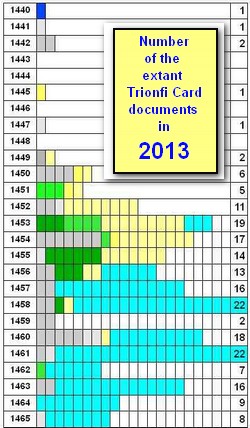 READ MORE
READ MORE
|
|

